This is a list of the cattle breeds considered in France to be wholly or partly of French origin. Some may have complex or obscure histories, so inclusion here does not necessarily imply that a breed is predominantly or exclusively French. The list includes breeds from the overseas territories of France.

The Highland is a Scottish breed of rustic cattle. It originated in the Scottish Highlands and the Western Islands of Scotland and has long horns and a long shaggy coat. It is a hardy breed, able to withstand the intemperate conditions in the region. The first herd-book dates from 1885; two types – a smaller island type, usually black, and a larger mainland type, usually dun – were registered as a single breed. It is reared primarily for beef, and has been exported to several other countries.

The Aberdeen Angus, sometimes simply Angus, is a Scottish breed of small beef cattle. It derives from cattle native to the counties of Aberdeen, Banff, Kincardine and Angus in north-eastern Scotland. In 2018 the breed accounted for over 17% of the beef production in the United Kingdom.

The Holstein Friesian is an international breed or group of breeds of dairy cattle. It originated in the Dutch provinces of North Holland and Friesland and in Schleswig-Holstein in northern Germany. It is the dominant breed in industrial dairy farming worldwide, and is found in more than 160 countries. It is known by many names, among them Holstein, Friesian and Black and White.

The Heck or Munich-Berlin is a German breed or type of domestic cattle. It was bred in the 1920s by Heinz and Lutz Heck in an attempt to breed back the extinct aurochs. Controversy revolves around methodology and success of the programme. There are considerable differences between Heck cattle and the aurochs in build, height, and body proportions. Furthermore, there are other cattle breeds which resemble their wild ancestors at least as much as Heck cattle.

The Charolais or Charolaise is a French breed of taurine beef cattle. It originates in, and is named for, the Charolais area surrounding Charolles, in the Saône-et-Loire department, in the Bourgogne-Franche-Comté region of eastern France.

The Guernsey is a breed of dairy cattle from the island of Guernsey in the Channel Islands. It is fawn or red and white in colour, and is hardy and docile. Its milk is rich in flavour, high in fat and protein, and has a golden-yellow tinge due to its high β-carotene content. The Guernsey is one of three Channel Island cattle breeds; the other two are the Alderney, which is now extinct, and the Jersey.
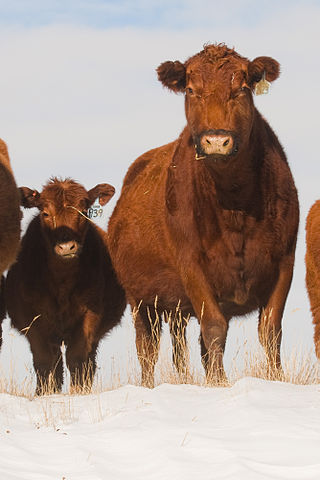
The Red Angus is an international breed of beef cattle characterised by a reddish-brown coat colour. It derives from the Scottish Aberdeen Angus population and is identical to it in all but coat colour. Red Angus are registered separately from black Angus cattle in Australia, Canada, and the United States.

Dairy cattle are cattle bred for the ability to produce large quantities of milk, from which dairy products are made. Dairy cattle generally are of the species Bos taurus.

The Ayrshire is a Scottish breed of dairy cattle. It originates in, and is named for, the county of Ayrshire in south-western Scotland. Ayrshires typically have red and white markings; the red can range from a shade of orange to a dark brown.
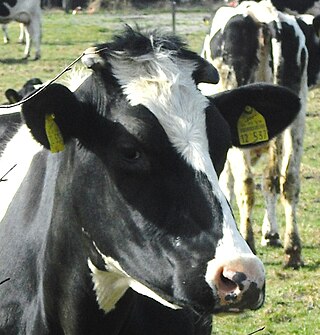
German Black Pied cattle are a breed of dairy cattle that originated in the North Sea coast regions of northern Germany and the Netherlands.

The Aubrac or Laguiole is a French breed of beef cattle. It originates on the Plateau de l'Aubrac in the Massif Central in central southern France, from which it also takes its name. It has a wheat-coloured coat and dark hooves, switch, muzzle and eyes.

The Montbéliarde is a breed of red pied dairy cattle from the area of Montbéliard, in the département of Doubs, in the Bourgogne-Franche-Comté region of eastern France. It is used mainly for dairying and particularly for cheesemaking.

The Pinzgauer is a breed of domestic cattle from the Pinzgau region of the federal state of Salzburg in Austria. It has distinctive colouring, with chestnut-brown sides and white back and underside. It was in the past a triple-purpose breed, raised for meat, milk and draught use. There is a naturally polled sub-type, the Jochberg Hummel. In 2007 the breed was not considered by the FAO to be at risk.

The Japanese Black is a breed of Japanese beef cattle. It is one of six Japanese cattle breeds, and one of the four Japanese breeds known as wagyu, the others being the Japanese Brown, the Japanese Polled and the Japanese Shorthorn. All wagyu cattle derive from cross-breeding in the early twentieth century of native Japanese cattle with imported stock, mostly from Europe. In the case of the Japanese Black, the foreign influence was from European breeds including Braunvieh, Shorthorn, Devon, Simmental, Ayrshire and Holstein.
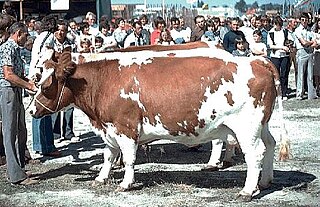
The Pie Rouge des Plaines is a modern French breed of dairy cattle. It was created in about 1970 by cross-breeding the traditional Armorican cattle of Brittany, in north-western France, with red-pied cattle of the Dutch Meuse-Rhine-Yssel and German Deutsche Rotbunte breeds.
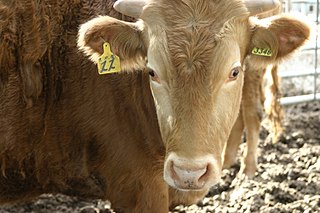
The Hanwoo, also Hanu or Korean Native, is a breed of small cattle native to Korea. It was formerly used as a draught animal, but this use has almost disappeared. It is now raised mainly for meat. It is one of four indigenous Korean breeds, the others being the Chikso, the Heugu and the Jeju Black.

Norwegian Red is a breed of dairy cattle developed in Norway starting in 1935.
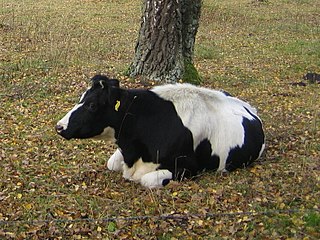
The Swedish Friesian, Swedish: 'Svensk Låglandsboskap', often abbreviated to SLB, is a Swedish breed of dairy cattle. It was established in about 1870 from imports of cattle of Dutch Friesian or German Black Pied type. From about 1970 it has been systematically cross-bred with the American Holstein-Friesian breed, to the point that the original Swedish type may be extinct. The name Swedish Holstein may also be used.It is a type of Swedish cattle breed.
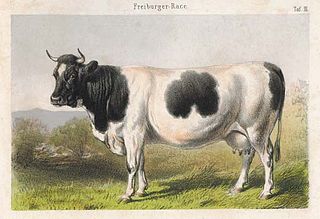
The Fribourgeoise or Freiburger was a Swiss breed of cattle from the Canton of Fribourg in western Switzerland. From about 1966 it was systematically cross-bred with imported Holstein stock. It became effectively extinct with the death of the last pure-bred bull in 1973, and was absorbed into the Swiss Holstein.